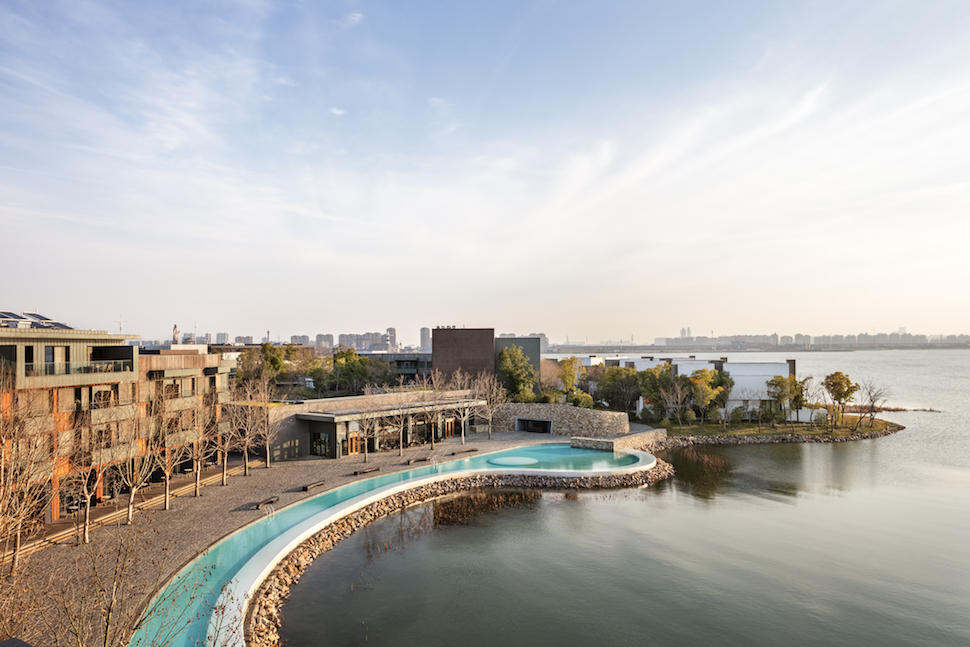
In physics, “quantum change” is an abrupt change in energy state with no in-between. In psychology, quantum change is “a vivid, surprising, benevolent, and enduring personal transformation that involves a significant alteration in how one perceives other people, the world, oneself, and the relationships among them.” In the world of wellness destinations, quantum change is a 46-acre waterfront retreat called Sangha Retreat by Octave in Suzhou, China, that was opened recently by Frederick Chavalit Tsao. The idea is that groups will visit the retreat complex to learn the Quantum Leadership skills that helped transform Tsao into a global business leader and billionaire—and thus Sangha will transform the world.
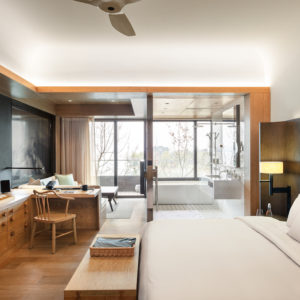
Lakeview Junior Suite King
My own quantum change at Sangha began on Friday morning after waking up from a deep sleep in a beautifully appointed room on the fifth floor overlooking Yangchen Lake. I pulled on yoga clothes, hurried downstairs, and was escorted along a cobble path to a subterranean dome where I joined a group for an hour of profoundly gentle breathing exercises. Afterward, I wandered alone along an empty cobbled street admiring the new, multimillion-dollar waterfront villas, and then opened a glass door to what proved to be the medical center. Immediately, I was offered tea, a tour of the facility by the head of Traditional Chinese Medicine (TCM), and the chance to experience three new machines that can quickly give any guest a health assessment ranging from body composition to organ health to overall energy. Alas, the nurse had me try the energy assessment three times, and each time what should have been yellow or maybe red across my chest area was black.
“Am I dead?” I wondered aloud.
“No, no,” the nurse replied. “Only energetically.”
The TCM doctor looked at my results and suggested I come back in a couple of days and retake the test. “Maybe jet lag?” he said. But I had flown business class on Cathay Pacific and slept well on the plane—and had recently rowed a couple of fine races with my former Olympic teammates in Boston. Before learning I was dead—if only energetically—I felt fine, and had come to Sangha to experience Fred Tsao’s At One International Festival and help usher in a “a new paradigm, new era of wellbeing.” Now that my own wellbeing had been ushered out, I stepped outside wondering, “What have I wandered into?”
In the sixties, Esalen gave birth to the Human Potential Movement. In the eighties, Canyon Ranch gave birth to the high-end wellness lifestyle. Sangha is built on both revolutions, but it’s giving birth to a completely different revolution for a radically different world.
Fred Tsao’s brother, Calvin, the noted Harvard architect who designed the entire retreat complex, says he traveled for inspiration for Sangha to classic revolutionary places like Esalen Institute and Canyon Ranch, and that makes sense. In the sixties, Esalen’s isolated hot tubs on the Pacific cliffs near Big Sur gave birth to the Human Potential Movement. In the eighties, the mix of state-of-the-art medical facilities and spa at a high desert ranch outside Tucson gave birth to the high-end wellness lifestyle. Sangha is built on both revolutions, but it’s giving birth to a completely different revolution for a radically different world.
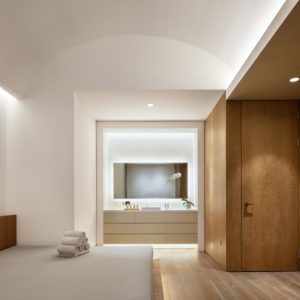
At One Spa Thai massage treatment room
For example, I could leave my home in Southern Oregon this morning and drive 12 hours to Esalen along the gloriously desolate coast road, and likely get in the gate for a $30 post-midnight soak. Esalen still holds that aura of wild freedom and spontaneity. By contrast, my first step toward Sangha was a $400 tourist visa, which required a complete travel itinerary, an explanation of why I was going, a photograph for facial recognition, and three months of bank statements. I then flew through Hong Kong to Shanghai, a city of 24 million, and then travelled by car about an hour and a half inland on busy modern highways to Suzhou, which totals about 12 million people. So, that fairly short drive connects as many as people as live in California, and they’re housed in orderly and often extravagantly lit high-rises as far as the eye can see.
Against this backdrop, Sangha is a billion-dollar super-urban oasis that feels like a small village just coming to life. Along with the five-story, 64-room retreat and the medical center is the largest spa in Asia, a public “town hall” that seats about 1,000, a hotel, outdoor amphitheater, shops, museum, and 106 waterfront villas that stand empty as Fred Tsao makes up his mind what to do with them. Imagine building 106 multimillion-dollar villas without having to know?
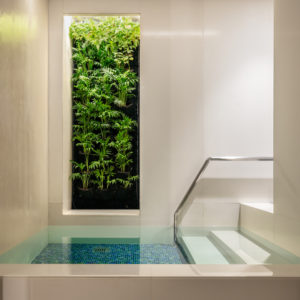
At One Spa cold plunge
What I did know is that is I felt shaken leaving the medical center and had time to kill before the festival began. So, I made my way to the At One Spa, which I had heard was truly spectacular. Sure enough, the spa’s grand entrance tunnel off the reception area is a couple hundred feet long, a soothingly imaged journey that begins with the removal of shoes and the ring of a bell and ends with everything you can imagine: An Olympic-size pool with warming jets as big as fire hoses, steam room, sauna, cold plunge, salt room, Kneipp walk, Turkish hammans, vibrating musical chaises, hanging chairs, and of course many treatment rooms. The stone workmanship was amazing and the place so big that I got lost—which was disconcerting, as I was the only person there.
Was this a billion-dollar belly flop?
What was going on?
A couple of hours later, I got a glimmer of understanding. In the amphitheater was the At One International Festival’s opening ceremony, which aimed “to capture the essence of oneness with heaven,” and featured musicians and dancers from all over the world in front of a three-story video screen displaying digital art to the music. Fred Tsao gave the opening “grounding meditation,” and we then watched the “illumination of the Dao” and listened to the “sounds of the universe.”
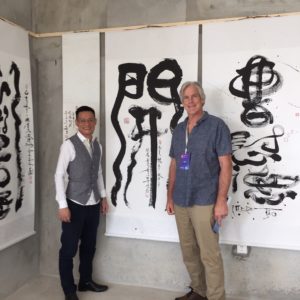
Renowned calligrapher Ricki Wei and author Stephen Kiesling
Eventually, the cheerful crowd moved to a great lawn for a bonfire and cacao ceremony. This was serious fun, and for the next couple of days I forgot about being dead and immersed myself in the more than 100 workshops on subjects ranging from inclusive leadership to Ayurveda to yoga to voice and art. I had my energy drawn (no sign of death there!) by energy calligrapher Ricki Wei, listened to street musicians, and was wowed by magicians. I ate great food and saw old friends from places like Esalen and Canyon Ranch. I also met physicians like Ken Pelletier, MD, and Richard Berman, MD, whose work I have long admired. The Sangha At One International Festival was an amazing, thriving, pop-up world-village—which I think is what Fred Tsao plans to accomplish year round.
Alas, on Sunday, I was supposed to go back to the medical center to relive my deadness. I didn’t want to go, and was going to blow it off, but by then the unseen retreat gods understood my erratic perambulations well enough to schedule an escort. So, I went along, and learned I wasn’t to be retested on the energy machine: Instead, I was greeted by Judy Chen, MD, a topnotch cardiologist from the Western-medicine side of the center. A few minutes later, I was flat on my back attached to an EKG before heading to a cardiac ultrasound. I felt cheerful, but mostly in shock. And in the midst of all this Fred Tsao stepped into the examination room to ask how I was doing.
Imagine being in a very foreign land, flat on your back in some cardiological crisis, and the billionaire owner walks in. Many things go through the mind, including: Holy shit! This is serious! There was also the dumb question: How did he know I was here? But my biggest thought was: I really like Fred! He was in the thick of a huge gathering and was not only keeping track of his guests, he was checking in. I still can’t tell you what quantum leadership is, but I knew it when I experienced it. And while I still don’t know how Fred Tsao will choose to fill his villas, Sangha will be a fine community to live in. Wow!
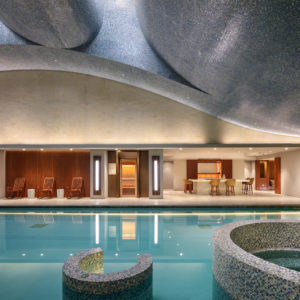
At One Spa Pool
What I told Fred is that I was fine and grateful, and he gave me a high five. He also asked me to bring friends to the closing ceremony. A few minutes later Dr. Chen confirmed that my energetic death was atrial fibrillation, the most common form of arrhythmia. For some reason, A-fib is an epidemic among former Olympic rowers, and several of my friends race with it. Not great, but no big deal.
So, I left the clinic and walked out to the amphitheater for the closing ceremonies feeling much relieved. Soon Fred was on stage leading another guided meditation in Chinese. I didn’t understand a word, but it felt good. Next came music and dance, and then, as darkness began to fall, so did the rain. At first the drops falling through the spotlights seemed a spectacular visual effect. As it started to pour, however, the crowd woke up to flee. Then the kirtan singer onstage called us to wait: “The rain is a blessing!” he cried out. We waivered, looking for shelter, and then gave in to the music, streaming down to the stage. Soon, several hundred people of various nationalities were on or around the stage, dancing arm in arm, and Fred Tsao was holding a microphone to my mouth as I belted out a classic refrain, “We . . . are the champions . . . of the world!”
Stephen Kiesling
Stephen Kiesling is a writer and editor whose career was launched in 1982 with the classic rowing book The Shell Game and The New York Times Book Review, “Just as it is good that there was a riverboat pilot who could write…it is good that there is one true blue jock who can.” A Scholar of the House in philosophy at Yale, Stephen was a 1980 Olympic oarsman who also raced in the 2008 Olympic Trials. He learned journalism from T George Harris, a decorated World War II artillery scout and Time reporter who created Psychology Today. T George and Stephen launched both American Health magazine and Spirituality & Health, where Stephen continues as Editor at Large. He has written for the New Yorker, Sports Illustrated and Outside, was a spokesman for Nike, started a celebrated rowing club, and has built parks and playgrounds. He lives at Ti’lomikh Falls on the Rogue River in southern Oregon, where he writes for his wife Mary Bemis at Insidersguidetospas.com. Stephen is also the caretaker of one of America’s oldest Salmon Ceremonies and is working on a whitewater park and sculpture garden. He is interested in transformational retreats, anything to do with water, the Native American origins of our democracy, and the process of becoming what he calls an Earth-Indigenous Elder, a person who knows their own story from the beginning of time.